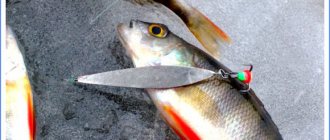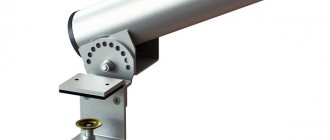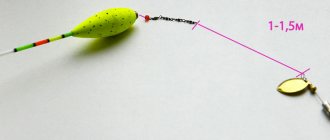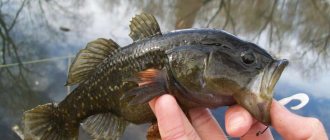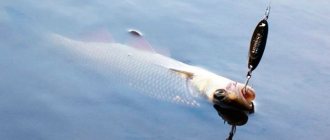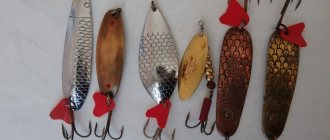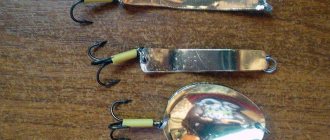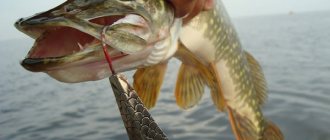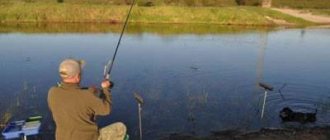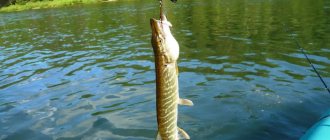First, let's get acquainted with rotan. This is a predator fish whose scales are gray-brown. Rotan inhabits small and swampy lakes, overgrown ponds, and dry river beds. This fish is unpretentious to living conditions, as well as to the lack of oxygen in the water. It is buried in silt when water bodies dry out completely and freeze. Rotan tries to avoid fast currents and does not like fuss. It hides in underwater thickets of plants, from where it conducts observation and hunting. Rotan bites in almost any weather and any time of year.
The best bite occurs not very far from the shore, in quiet thickets of reeds. Although rotan is a predator, it is not fast in its movements, and therefore does not particularly resist when pulled, which may appeal to amateur fishermen and beginners, and catching rotan can be a very interesting activity. Pieces of fresh meat, liver or lung are preferred as bait for rotan; worms are also good. Maybe he can also feast on his fellow creatures. The predator recognizes all these baits unmistakably. To catch rotan, a spoon is most often used. This is the best tackle, which creates strong swaying and swaying, which is what attracts the attention of the predator. Rotan, like all predator fish, reacts to the spinner, but in an unusual way. She irritates him more than attracts him. With all this, the fish will only pay attention if it feels and sees a large piece of tasty bait, which it will feel in its large mouth. This means that you need a larger hook than the standard one soldered into the spinners, and always with a long shank. The shape of the spinner for catching rotan, in principle, is not particularly important, but the color plays a major and important role. The spinner for rotan should be light so that he notices it and is better attracted. A larger soldered hook makes hooking more likely.
Spinner for rotan in winter
Winter fishing for rotan is gaining popularity. Catching it in winter is a pleasure. From the first weeks of ice formation on reservoirs, active biting begins. This fishing has one distinctive feature - you can witness rotans supposedly frozen into the ice. In fact, for fish this is just an opportunity to survive cold and frost. You can check this phenomenon yourself by taking rotan from the ice and placing it in a warm room. The rotan will miraculously thaw and come to life. It should be added that rotans freeze into the ice in whole schools in large numbers. Typically, fish of this species overwinter in ice thickness of about 1.5 meters, in the coastal zone, in thickets of aquatic plants, in the rubble of trees and shrubs. Having decided on a place, you need to make more holes, starting from the shore and moving inland. You can follow this tactic: make several rows of holes with a distance between them of 2-3 meters and approximately the same distance between the holes in the row. As you understand, this method provides more opportunities for successful fishing. Since rotan is grouped in schools, there is a possibility of a large catch even from one hole.
In winter, rotan is also caught with a spoon using a hook with a long shank. The technique is simple: a spoon with bait is lowered to the bottom and a few twitches are made. Rotan will not keep you waiting long if it is found there. Do not forget about hooking due to sharp rotan bites.
Thanks to these tips, you can catch a sufficient amount of this tasty fish in winter.
Rigging and tackle
Fishing for rotan is successful for both beginners and experts. The main thing is to choose the right gear.
For successful fishing you will need:
- ice ax;
- high chair;
- fishing rod with a hard whip;
- fishing line 0.25 mm (withstands any rotan);
- maggot, several pieces of meat (fresh), a jig (with a large hook) and a spinner (2-3 cm long, light color);
- whip;
- extractor.
Rotan can be caught using various gear: a float rod, a jig with a nod, etc., but according to the notes of many experts, homemade fishing rods are the most popular among gobies, which are very easy to make.
Eight blocks of 160x60x35 mm are cut out of a lightweight, non-sinking material (hard foam, polyurethane foam, solid insulation, in extreme cases a dry wooden block treated with sandpaper is suitable).
From the end of the upper part it is necessary to drill a small hole no more than 1 centimeter deep for the whip, and from two ends, closer to the bottom edge, cut-ins are made for winding the fishing line. Now you need to wind a fishing line with a diameter of 0.25 mm, 16-17 meters or, if you know the depth of the reservoir, wind the fishing line along its depth + 3 meters. The equipment is made as follows: a large jig or spinner with one hook will be attached to the remaining end of the fishing line, and a little higher, on the leash, one large single or double hook.
If desired, a sinker is attached to the end of the fishing line, and 3-4 large hooks are attached to the leashes. Hooks will be needed for attaching meat or a bunch of maggots. The meat must be placed in small pieces; the rotan will take the bait until the meat turns white and loses its meaty appearance. Under no circumstances choose small hooks, since the head of the rotan is 35% of the length of the entire body, and if a small hook goes deep, pulling the hook out of the toothy mouth is not a very pleasant and long process. This is why you need to take an extractor with you.
For those who do not have the opportunity to make rods for catching rotan, “balalaikas” are ideal. According to the notes of experienced fishermen, it has been established that the most suitable fishing rod is the SalmoIFR-1000 using small and medium jigs. For using large jigs, a “wheel” rod is perfect for better play with rotan due to its longer handle.
It is better to choose a bright, light jig, perhaps with phosphorus drops. Rotan perfectly takes jigs made from a hook with two or three balls. Color does not have much effect, the main thing is that the bait is light.
The fishing line must be 0.25 mm, it will withstand rotan for more than one year, even if it loses its elasticity. The brand of fishing line is not important, just like the color.
Tying jigs and spinners to fishing line
In order to reliably fix a jig, you need to remember two main types of knots, which are fundamental: tying the jig to the forearm with an eye and a knot that is used directly for a jig with a small hole.
First way. For jigs made with a hole and without an eye, made from an alloy of hard metals, such as tungsten, conventional tying methods are not suitable. In this case, you need to avoid contact of the fishing line directly with the jig itself, since after two or three hooks the fishing line will break without using much effort. This is due to the fact that the hard metal alloys from which jigs are made, even of very high quality, very quickly contribute to line breakage.
Using an ordinary fishing line, which will be the main one, the braided line is threaded through the hole in the jig so that the height of the loop is 2-3 millimeters (there is no need to remove the fishing line from the loop). The ends of the braided cord (one counterclockwise, the other clockwise) are wound around the shank of the hook and tied with a regular or double knot. The main part of the fishing line is tied into one of the fishing knots, as for hooks with an eye.
The second method is a little more complex, but more advanced, used by a large number of expert fishermen both in everyday fishing and in competitions.
The jig is “upgraded” by threading a very elastic polyvinyl chloride cambric through its hole. The more accurately the jig is made, the thinner the hole is drilled in it, and the thinner the cambric is needed for it.
Selecting the required cambric is sometimes very difficult, but the problem is easily solved - the selected cambric (it is better to buy several different ones) is heated in water at a temperature of +80-90 degrees Celsius, then lengthened until the desired cross-section is obtained. It is worth noting that not all PVC cambrics have the required elasticity, and therefore you may have to go in search of a suitable one and conduct a series of small experiments with cambrics.
In order to fix the cambric in the jig, it needs to protrude from the edge of the jig by 2-3 millimeters; the edges of the cambric then need to be heated with a flame until it is firmly fixed. Tungsten jigs with an eye are tied naturally, like regular hooks, using simple fishing knots.
Lure
The bait should be used a day before catching rotan, throwing several pieces of meat with blood into the hole or lowering a small stone into the water, on the cut of which put small pieces of meat, since this fish does not like to move from place to place, then after about a day it once he moves under the holes. As for artificial baits, FishHungry and any protein-based baits work very well.
Catching rotan in summer using a spoon
In the summer, when the water in reservoirs heats up to significant temperatures, the summer rotan fishing season opens. Finding this fish will not be difficult, as it is found in many reservoirs. But rotan, one might say, prefers peace and tranquility, as well as the absence of other inhabitants, especially predatory ones, such as pike, for example. Large individuals can be looked for among thickets of plants, but this is not the rule. In the summer, rotan loves worms as bait, but does not shy away from other meat delicacies. It is worth noting that the freshness of delicacies is very important and essential for rotan, so it is better to change the bait more often. It is unlikely that rotan will bite immediately on the first cast. First he will watch from ambush. But after several casts, the fish will forget about its wait-and-see tactics and begin to attack your bait. The grip of the rotan is strong, this fast and sharp jerk will make you feel it to the fullest. Therefore, an appropriate reaction is needed, that is, a swift and merciless cutting.
In summer, rotan is quite active and greedily bites. It happened that you could catch a bucket of fish with a single bait. In this position, the main thing is to have time to complete all the manipulations: pull out the hooks, attach the worm and cast again. Of course, it happens when the fish don’t bite for quite a long time. Then it is recommended to simply change the fishing location. There is another secret - to install a hard type nod, which is needed to create a certain level of sensitivity and is very effective.
As you can see, catching rotan in summer is exciting and interesting, and can become a favorite habit on summer evenings.
Fishing technique
You can successfully catch rotan with a spinning rod in a plumb line . In this case, a silicone worm is lowered into the water vertically, moving it by twitching the tip of the rod.
Some anglers practice retrieving when casting . But it is worth remembering that with such tactics, slow and smooth retrieval of the bait .
The optimal way to retrieve a weki worm is to slowly rotate the reel handle, twitch the bait with the tip of the spinning rod, and pause.
When fishing with a drop shot, you can play with the bait, leaving the sinker motionless on the bottom.
The optimal wiring option when fishing with wobblers is fairly soft twitching with pauses.
Bite and hook
In different situations, the bite of rotan can be decisive and greedy or, on the contrary, very cautious. Accordingly, in some cases (for example, when fishing with a twister with a jig head), the hook is usually immediate, while in others (fishing with edible rubber weckies ) it is better to give the fish a little time to chew the bait.
Do-it-yourself spinner for rotan
If you are a true fishing enthusiast, then it will not be difficult for you, and even on the contrary, it will give you great pleasure to make a spinner for rotan with your own hands. This is the best method to spend your time waiting for the season on something related to your favorite hobby.
To make a spinner for catching rotan, you will need the following materials: a piece of non-rigid metal sheet; sandpaper; scissors; alcohol marker; hook with a large hook; soldering iron with acid and solder; awl; pliers; file.
The process begins by marking a sheet of brass, from which rectangular sections are cut. Then the outline of the future spinner is outlined and the blank is cut out. To make bending the plate easier, a line is drawn on the back side of it with an awl. Next, the fold is made accordingly. When the metal is soft and not thick, this will not be difficult to do. If the metal is hard and thick, you will need a hammer and a vice to bend it. After heating the soldering iron in advance, the workpiece is serviced along with the hook. Then the spinner is coated with tin. The longest stage during the production of a spoon is its grinding and smoothing. So, the spinner is made. The result will delight you not only with its handmade work, but will also bring a lot of pleasure when catching rotan, namely, from the fact that it is “your own” spinner.
I would like to hope that our recommendations will be useful in your fishing for rotan with a spinner and will bring you many pleasant experiences!
How to catch rotan
Our fishermen have successfully adapted the most common methods of fishing with float and spinning rods to catch firebrands. Recently, the method of catching rotans using a fishing rod with a nod has become no less popular. If float and nodding tackle mostly allow you to hunt for a medium-sized rotan, then spinning fishing with spinners and edible silicone is used purely for catching large rotan. Next, in continuation of our article, we will consider these effective fishing methods in an individual analysis with some nuances in their equipment.
On a float rod
For float rigs, lightweight fly rods and Bolognese rods with a length of 4 to 6 meters are used. The lightness of the gear is needed for dynamic fishing, which becomes a direct consequence of the angler discovering a place for feeding fish. The short length of the rod is explained by the factors of the predator’s habitat near the coastlines and weak response to extraneous noises, which, most likely, can even additionally attract fish to the fishing site. They put a 0.2 mm monofilament line on the fishing rod, without worrying too much about the fineness of the installation. Floats are used of sticker or spindle-shaped type weighing from 1 to 3 grams. Loading one lead pellet of the required mass effectively complements the installation. Fishing is carried out using a leash of 0.15-0.18 mm, 15–20 cm long.
Important! The hook, regardless of the bait, must be used with an extended shank. The fish swallows the bait heavily, which makes it much more difficult to remove a short hook from its mouth, even with the presence of an extractor
https://youtube.com/watch?v=tv2R35gqZak
Fishing for rotan using a spinning rod
Catching rotan with a spinning rod requires more delicate equipment than float tackle. Ultralight spinning rod is the most accurate option for hunting for firebrands. A short rod of 1.5-2.0 meters allows you to make accurate casts at short distances. A 0.2 mm nylon fishing line is used as a cord. The equipment contains a sufficiently inertia-free coil with high gear ratio parameters
Fine adjustment of the clutch is not so important, due to the large size fish initially not planned for catches
Important! Fishing for silicone is carried out using the drop-shot technique or jig. Postings are carried out at low speeds with second pauses, making a short step
Read: What are the types of spinning baits and how do they work?
The rotating spoon is dragged along the bottom.
The bite of rotan is not distinguished by impudence, it is rather with a soft blow, which, with rough installation and still little experience in spinning fishing, can be easily missed, mistaking it for the bait to bypass an underwater obstacle. Fishing is calm, without forcing, on an ordinary winding of the cord using a reel.
On the fishing rod with a nod
For the nodding method, fly rods up to nine meters long are used. The 20 cm long nods are made of lavsan, giving the tip of the alarm a distinct orange color. The fishing line is stored on a reel attached directly to the quiver tip of the tackle. As in float fishing, monofilament is taken in a thickness of 0.2 mm. The installation includes jigs with a catchy red color and a hook with an extended shank.
https://youtube.com/watch?v=t5QV_civJCA
Important! To increase fishing efficiency, a worm, maggot or bloodworm is placed on the jig hook. Jigs are cast with sharp throws, catching the water horizon from the very bottom to a level of forty centimeters
The most promising places are windows in thickets and trajectories near the walls of coastal cattails or reeds
They fish jigs with sharp throws, catching the water horizon from the very bottom to a level of forty centimeters. The most promising places are considered to be windows in thickets and paths near the walls of coastal cattails or reeds.
